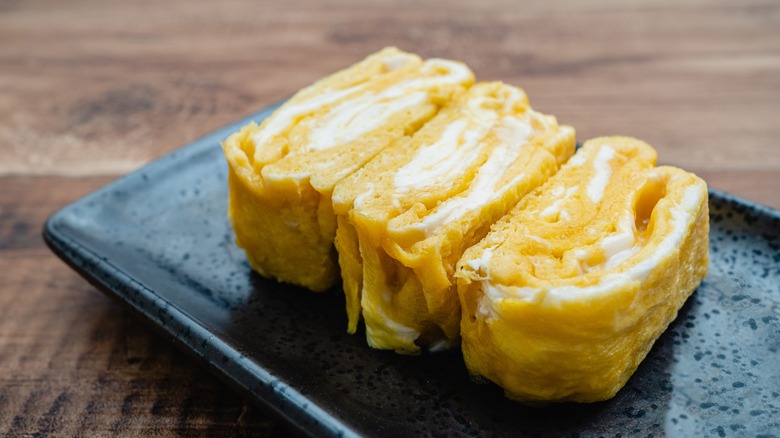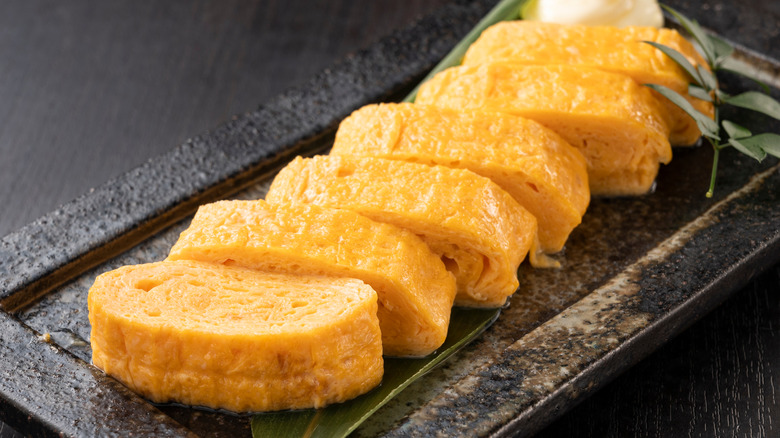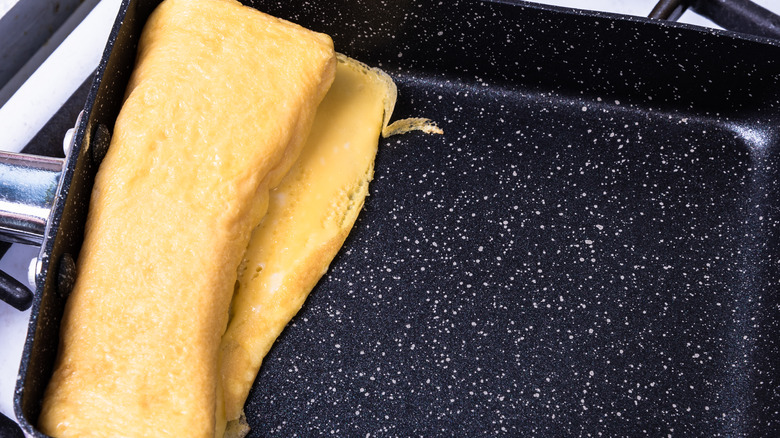Tamagoyaki: The Japanese Rolled Omelet You Should Know
If you've seen tamagoyaki on a plate, you'd think it's tough to make: Delicate layers of an omelet are stacked carefully into small, compact shapes (per Just One Cookbook). It seems like a challenge for any culinary master, yet this Japanese dish can, in fact, be made at home. In fact, we have a tamago omelet recipe to get you started.
"Tamago" is the Japanese word for egg, and "yaki" means grill, according to Just One Cookbook. While tamagoyaki has become known as the general category for these delightfully satisfying egg presentations, you can find several varieties with varying textures, ingredients, and preparation styles. Tamagoyaki can be included in breakfast spreads, as one of the items packaged into a bento box, or can be incorporated into sushi dishes.
One Bon Appétit writer recognizes that simply reading instructions on how to make tamagoyaki can seem tricky, but there are plenty of YouTube tutorials to help you understand the process of folding egg layers in either a nonstick frying pan or a rectangular-shaped pan meant for tamagoyaki making.
How to make tamagoyaki
You may notice Astuyaki Tamago and Dashimaki Tamago on some menus. Just One Cookbook explains the Astuyaki variety is more firm and easier to make than Dashimaki, which contains more liquid in the raw egg mixture and results in a softer, less dense tamago.
According to Bon Appétit, you can ignore all of the recipes that tell you to add sugar, salt, vinegar, soy sauce, and miso into your raw eggs; instead, reach for sake, mirin, and dashi — and add only a pinch of salt and sugar. Dashi is the ingredient that will help you make the fluffiest, tastiest eggs you've ever had, but it can be tricky to use (via Just One Cookbook). You can make your own with this broth recipe; not only will dashi build flavor and add texture to tamagoyaki, but it can enhance stews, as well. Start with 1 tablespoon of dashi per egg. You can always add more as you continue practicing your tamagoyaki skills, but whatever you do, do not forget to oil your pan.
More is more
More is more when you're using oil to make this egg dish. If eggs stick to the bottom of your pan, your quest for the perfect foldable omelet could be foiled. As you roll up layers of cooked eggs, you will add more layers by lifting up the already cooked eggs and pouring in more of your seasoned mixture (per Just One Cookbook). Each subsequently cooked layer will be wrapped around the mass you've already formed. The goal here is to keep wrapping, and your little egg omelet will slowly grow in size.
When you're finished, if the shape isn't what you had imagined, you can slice off unsightly edges or try to form it with whatever you can find in your kitchen — plastic wrap, cloths, spatulas, even your hands. Your first few attempts won't be pretty, but you must persist. Not only can making tamagoyaki at home give you the privacy to practice, but at-home chefs can also experiment easily with different ingredients. Japanese Cooking 101 recommends adding pickled red ginger, cooked spinach, chopped ham, dried green seaweed, or other meats and vegetables. Feel free to adjust home recipes to suit your preferences.
If you can't imagine yourself practicing this egg-making technique, we have a marinating hack that can take eggs to the next level without all this layering fanfare.


